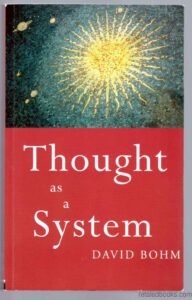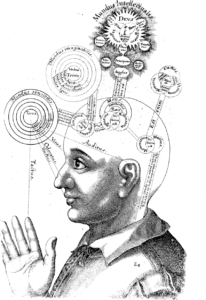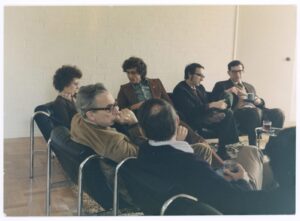Your cart is currently empty!

Bohmian Psychology: The Undiscovered Continent of David Bohm’s Worldview
the December 2020 issue of Pari Perspectives.
Part I
David Bohm is known primarily as a theoretical physicist who made important contributions to both quantum mechanics and cosmology. His insights into quantum theory were revolutionary and have garnered increasing attention every decade since they were first introduced in 1951. So profound and influential were his contributions that they have entirely overshadowed his equally significant insights into psychology, consciousness and human behaviour. Bohmian psychology represents an undiscovered continent of David Bohm’s worldview: a highly original and comprehensive set of ideas that was extremely important to him but remains almost wholly unknown even among those most interested in his work.

Several factors have contributed to this strange state of affairs. Foremost among these was Bohm’s reluctance to commit his psychological views to writing, although at the end of his life he allowed a book-length transcript to be published of a seminar he conducted in this field (Thought as a System). Moreover, he may have felt that his investigations into psychology were not complete. He may even have questioned whether his views would be taken seriously, since psychology was not his primary field or one in which he held academic credentials.
In any case, he did leave behind a sufficiently complete record of his views—most of it still unpublished—that we can reconstruct this undiscovered continent in considerable detail. His understanding of human behaviour and consciousness was vast, replete with unexpected insights, and highly original. His views were expressed with clarity and force, and frequently illustrated with colourful examples and metaphors. His outlook was not abstract or speculative but highly relevant to human affairs and full of concrete applications to daily life.
The general tenor and principal themes of Bohmian psychology represent a profound contrast with the point of view inherent in his physics and cosmology. Many observers have noted Bohm’s emphasis on wholeness and interconnectedness in his understanding of our physical environment, and they have often extrapolated those qualities to the psychological field. Articles and talks have been devoted to topics such as ‘quantum consciousness.’ Because Bohm observed wholeness in the physical universe, many commentators have assumed he would find wholeness in the human realm as well. In fact, such idealistic assumptions are largely unfounded.
The conception of human consciousness that emerges from Bohmian psychology is one in which conflict and disorder are the primary characteristics. Most of his attention in the psychological field is devoted to a diagnosis of the sources of this disorder and the possibility of finding some remedy. Bohm appears to hold out hope that some degree of wholeness can ultimately be restored to humanity, but the path to such a result is difficult at best, and the prospects for success are not favourable. If there is a remedy, it lies in a comprehensive dedication to understanding the nature of the problem. Wholeness in the human realm will never be achieved, according to Bohm, unless and until we give our total attention to understanding the present reality of conflict and disorder.A similar discrepancy exists with respect to the image and the reality of Bohm dialogue. The prevailing image of Bohm dialogue is one of harmony and cooperation, a forum in which the participants cultivate a spirit of cooperation without rancour or antagonism. The reality of what Bohm proposed is entirely different. He explicitly cautioned against participants engaging in a ‘cozy adjustment’ with one another. He advocated for a minimum of twenty members of a dialogue group precisely in order to ensure that conflict and discord would inevitably emerge. Harmony and cooperation in a true Bohm dialogue are at best a distant light at the end of a long and arduous tunnel. He repeatedly likened the process to the challenge of climbing Mt Everest: a very difficult endeavour that demands intense and sustained dedication.

One final issue deserves consideration in our effort to understand why Bohmian psychology remains an undiscovered continent of David Bohm’s worldview. Much of Bohmian psychology coincides with, and was developed in coordination with, the philosophy of J. Krishnamurti. As described in my book, An Uncommon Collaboration, the two men worked together for twenty-five years and engaged in dozens of recorded dialogues. But their relationship was controversial and misunderstood by many of Bohm’s peers in the scientific community. They wrongly perceived Krishnamurti to be representative of Eastern spiritual or mystical traditions, and they recoiled from Bohm’s association with that.
The false understanding of Krishnamurti is epitomized by the erroneous label often attached to him: ‘Indian philosopher.’ While Krishnamurti was in fact a kind of philosopher, the qualifier ‘Indian’ represents a severe distortion. It implies that Krishnamurti was an exponent of Indian philosophy. It suggests that he identified himself with the nation of India. It pigeon-holes him in a category that most Westerners associate with gurus, mystics, and cults of personality.
Each of these associations with Krishnamurti is not only false but offensive to his work. He was born in India, but from age fifteen to twenty-seven, he lived mainly in England, and thereafter, until he died at ninety, his primary home was in the United States. If he were to be identified by his nationality, he should be called an American philosopher. That would remove, in a single stroke, the false associations with gurus and mysticism.
More deeply, however, Krishnamurti categorically rejected any identification with any nation or nationality. This was not an incidental or secondary issue to him. His rejection of nationality was deeply felt and extensively described in his philosophy. He considered nationalistic identification to be divisive, false, and a significant contributor to war. To label him according to any nationality, therefore, flies in the face of one of the essential principles of his point of view.
Above all, Krishnamurti was not an Indian philosopher because he was not in any respect an exponent of Indian philosophy. He insisted that any form of authority in the psychological field is inimical to clarity, understanding, and freedom. He advocated approaching psychological issues without preconceived beliefs, traditions, or received philosophies. This was a central pillar of his entire perspective.In the United States especially, the label ‘Indian philosopher’ effectively serves as a barrier to further interest or investigation for the large majority of the population. Gurus and mystics are regarded sympathetically by only a slender minority. The name Krishnamurti alone is sufficient for many to block further interest, and the ‘Indian philosopher’ label serves to confirm what the name already suggests. The actual substance of what he had to say is never even considered by a wide segment of the public.
Krishnamurti’s philosophy, articulated hundreds of times from public platforms across multiple decades and continents, is neither mystical nor Indian. It is a detailed, factual exposition of the psychological dynamics of daily life and ordinary individuals. It is about the problems and struggles of normal people as they attempt to navigate the challenges of the modern world. The topics he addresses are issues like conflict, fear, perception, violence, freedom, knowledge, nationalism, ambition, and personal identity.
These are also the issues that were of interest to Bohm, and they form the substance of his own psychological views. The close association of Bohm with Krishnamurti, coupled with the false images associated with ‘Indian philosopher,’ go a long way to account for why Bohmian psychology remains an undiscovered continent.
Part II

Even as a young man, Bohm was interested in understanding basic human relationships. As David Peat explained in the film, Bohm’s attraction to Marxist theory, for example, extended even to his ideas about plasma, which he developed as a graduate student at the University of California at Berkeley. Bohm saw an analogy between the electrons in the plasma and human freedom. This shows that his interest in Marxism was not just as an economic theory, but about the conditions for freedom in the individual and society.
In addition, Marxist theory has its roots in the philosophy of Hegel, which Bohm studied for many years. Even after Berkeley, Princeton, and Brazil, when Bohm met his wife Saral in Israel, she recalled that he was often carrying a thick volume of one of Hegel’s books. And parts of Hegel’s philosophy are very psychological. His most important book is The Phenomenology of Mind: The Science of the Experience of Consciousness.
When the physics community failed to appreciate the importance of Bohm’s papers on hidden variables, he interpreted that event in psychological terms. He made this clear in his book Causality and Chance in Modern Physics. There he explained that the orthodox interpretation of quantum mechanics was based on a psychological prejudice. It was a set of preconceived assumptions that was not grounded in any experimental evidence.

This is some of the background in the psychological field that helped prepare Bohm for Krishnamurti. He read The First and Last Freedom, which presents a comprehensive overview of the whole of Krishnamurti’s philosophy. Bohm’s interest in Krishnamurti was a natural extension of his interest in society, individual freedom, the scientific quest for understanding, and Hegelian philosophy.
Bohm was forty-three years old when he first met Krishnamurti, in 1961. Within a few years, he was very engaged in exploring what Krishnamurti had to say. During those years, Krishnamurti conducted a series of talks every summer in Switzerland, and Bohm began travelling there to attend those talks every year.

In 1969, Krishnamurti opened the Brockwood Park school in England, about seventy miles south of London. Bohm and Saral visited the school almost every weekend, even when Krishnamurti was not present, to spend time with the students and staff and talk about how to adapt Krishnamurti’s educational philosophy to a private secondary boarding school.
The next major development occurred in 1975, when Krishnamurti started the Oak Grove School, near his home in Ojai, California. Oak Grove is an elementary and secondary school, with an enrolment today of more than two hundred students in kindergarten through 12th grade.
From the first year that the school opened, David and Saral came to Ojai and spent five or six weeks there each year. They always stayed in the same apartment, upstairs over an office building located near Krishnamurti’s cottage. In fact, that apartment came to be known as the Bohm flat.Bohm came to Ojai for several weeks every year from 1975 until 1985, the year before Krishnamurti died. After that, at first it seemed he would not be coming any more, since the main purpose of his visits was to visit and talk with Krishnamurti. For many of us in Ojai, the prospect of Bohm not coming was very regrettable, as he had developed many close friendships there.
So a few of us formed a committee and developed a proposal to see if we could get Bohm to come back to Ojai. Our idea was to arrange for him to conduct a weekend seminar. We would sell tickets for people to attend, and in this way we would raise enough money to pay the air fare for Bohm and Saral to travel from England. When we presented this proposal to Bohm, he agreed to give it a try.
It was understood from the beginning that these seminars were not for the purpose of having Bohm discuss quantum theory or the implicate order. People in the Krishnamurti world hardly understood anything about Bohm’s contributions in those fields. We knew that he was a well-respected scientist, but his main qualification to us was that he had conducted a very successful series of dialogues with Krishnamurti. And so it was understood that these seminars would be for the purpose of discussing psychological issues.

The first seminar occurred in the Oak Grove school library in December 1986. Each seminar took place on Friday evening, Saturday morning, Saturday afternoon, Sunday morning, and Sunday afternoon—about ten hours altogether. We sold tickets to fifty or sixty people who knew about Bohm through his work with Krishnamurti.
These seminars were carefully recorded on high quality equipment. We had each seminar transcribed, lightly edited, and then reviewed and edited by Bohm. We created copies of the transcripts, and made them available for sale at the next seminar the following year. The transcripts of those seminars represent the primary legacy we have and the only complete expression of Bohm’s views in the psychological field.

Bohm conducted these seminars in 1986, 1987, 1988, 1989, and 1990. The seminar in 1990 was submitted to his publisher, Routledge, and published as a book, Thought as a System. But the seminars in the previous years go into many additional topics that don’t appear in Thought as a System.
Bohmian psychology is very much influenced by Krishnamurti’s philosophy, but it includes some additional elements, all expressed in his own language, with his colourful metaphors and examples. Bohm’s contribution was to distil some of the essential elements of Krishnamurti’s philosophy and fine tune it in certain respects. Perhaps sixty percent of Bohmian psychology overlaps with Krishnamurti, and the rest comes from his background in science, his study of Hegel, and from various others, including Piaget, Freud, and Korzybski, as well as his own unique and original insights.
Part III
Bohmian psychology is unlike conventional psychology in several respects. It is not concerned with analyzing individual differences among people, such as demographic variations, or the effects of different cultures. It is not concerned to categorize particular forms of mental disorder, such as bipolar illness or depression or autism. Instead, Bohm takes as his subject matter the whole of humanity, the psychological characteristics of the human species.

The point of departure for Bohmian psychology is the total global human disorder, including war, environmental degradation, climate change, racial and religious hatred, extreme economic inequality, and discrimination against and exploitation of women. Bohmian psychology poses the question, what is the source of this global human disorder?
Bohm proposes that the source of the disorder lies fundamentally in our collective failure to understand the nature and function of thought. He acknowledges the great contributions of thought to the development of art, science, technology, and civilization. He recognizes that thought is the tool we employ universally to solve all our problems. So to attribute the human disorder to thought seems very strange at first. It’s somewhat like saying that going to the doctor is what is making you sick.
But Bohm maintains there is a great deal about thought that is not well understood. We normally give our attention to the content of thought—our knowledge, beliefs, ideas, objectives, opinions, fears and desires. But we give little attention to the process of thought, the manner in which it works. And there are some flaws or weaknesses in the process of thought which occur no matter what the content or subject matter. These flaws then feed back into the content in unpredictable and often dangerous ways.
One of the characteristics of thought is that it usually proceeds on the basis of assumptions. Assumptions are part of thought, but they are often implicit, so we don’t pay them too much attention. For the most part, that is a good thing. In the language of computer software, not being aware of our assumptions is a feature, not a bug.
Bohm gives the example that if I want to walk across the room, I have the assumption that the floor will be solid and support me, and I won’t fall through it anywhere. And normally that is a good and useful assumption. Part of its value is precisely that we don’t have to think about it.
Because we don’t usually think about our assumptions, we often don’t even realize that we have them. But when people disagree about issues that are important to them, very often the root of their disagreements lies in their different assumptions.
Bohm used a metaphor to describe how we should hold onto our assumptions. He said, think of a blind man who is holding a stick to tap the ground ahead of him as he walks. If he grips the stick very tightly, he can’t really use it to tap and sense the ground. But if he holds the stick too loosely, it is also useless and he is liable to drop it. So the blind man needs to hold the stick with a reasonable amount of firmness, but not too much. And that is how we should hold onto our assumptions—firmly enough to make use of them, but not so tightly that they are counter-productive.
Another important attribute of the process of thought involves the issue of fragmentation. Bohm considers fragmentation to be one of the primary characteristics of the global human disorder. He sees fragmentation taking place both outwardly in society as well as inwardly within the individual.One important place we can see fragmentation is in the relationships among nations. In reality, all the nations of the world are extremely dependent upon one another, and the actions of any one inevitably affect many others. Yet each nation regards itself as essentially sovereign, entirely independent of the others. That is a form of fragmentation, according to Bohm. It is a kind of division that falsifies reality and leads to conflict and ultimately to war.

Another form of fragmentation exists within the individual. An example of inward fragmentation consists of the separation of thought from emotion. We generally consider that our thoughts belong in one domain of reality, and our feelings are something separate. But Bohm shows that thoughts and emotions are closely interconnected, to such an extent that they should be regarded as a single, inseparable system. He demonstrates this in terms of the structure of the brain, and the neurophysiology of the nervous system, and he gives various examples from daily life.
So the idea that thought and emotion are separate and independent spheres is false. Thinking that way is a form of fragmentation, and it leads to confusion and incoherence in the way we function in daily life. For example, if thought and feeling are two separate domains, then we can try to control our feelings with our thoughts, as we often do. But if they are one inseparable system, then the effort to control one with the other makes no sense. It leads to inward conflict and incoherence.
Fragmentation arises, according to Bohm, because thought consists primarily of words and concepts, which are organized into categories. Each word or concept is based upon some kind of definition that draws a border around the thing defined. That border forms a limit, one that says, ‘this thing is this and not that.’ Every definition represents a limitation—the very word ‘definition’ is related to ‘finite,’ which means that which is limited.
The entire process of thought functions through constructing and defining the limits of things. This process is extremely useful in many areas of life. But it has a tendency to create limits that are too strong, too definite, too categorical. And so it separates things in a way that is not entirely faithful to reality, and it exaggerates differences more than is necessary and appropriate. Bohm says that is a major source of fragmentation.
A third important characteristic of thought is that it consists of a process of abstraction. ‘To abstract’ means ‘to take out.’ It has a meaning similar to ‘extract.’ So a thought abstracts or takes out from the very complex world of concrete reality. In so doing, it takes out the parts that are most salient or relevant and leaves behind what we consider to be less important.

As a result, every thought is more or less incomplete. Bohm liked to quote the linguistic philosopher Korzybski, who said, ‘Whatever we say anything is, it isn’t.’ That means that abstraction is always incomplete. And it is fine for thought to be incomplete in many cases and situations. That is part of what makes it useful. But it also leads to difficulties if we lose track of that incompleteness. We tend to believe that our thoughts are giving us a literal or perfect picture, and we overlook the fact that they are merely abstractions, an approximation of whatever they represent.
We have seen that the process of thought includes making assumptions, and using definitions and limits for words and concepts, and making abstractions from the information provided by our senses. The net effect of this process is that thought makes representations of the world, which we use to communicate with one another and for almost everything we do.
Bohm says that when we are consciously thinking of some thought or representation, that is explicit thought. After we are finished, we believe that the thought just goes away. Thought seems to be insubstantial and ephemeral, but Bohm says that is not correct. He says every thought leaves a trace in our memory, and it remains as implicit thought. And implicit thought, he maintains, has very powerful effects of which we are not aware.
To understand the effects of implicit thought, we have to consider the relationship between memory and ordinary perception. Our eyes and ears and physical sensations and mental perceptions altogether produce what Bohm calls a ‘presentation’ in consciousness. This presentation is the immediate input of our perception, our senses, and awareness in consciousness.
Thought is a form of knowledge or memory that is a representation, or re-presentation. The trouble begins when the representation enters into the presentation. Once the representation gets stored in memory as implicit thought, it is then ready to move into perception and shape our awareness of the world. According to Bohm, this is a very crucial move. The representation, in the form of implicit thought, enters into and fuses with the presentation of the senses in consciousness.
This is a crucial move because it happens without our being aware of it. Implicit thought acts very quickly, almost immediately, in such a way that we don’t distinguish between the perception and the representation. We take the representation as if it were part of reality, instead of as a memory introduced into awareness by thought.
In many respects, this is a good and useful process. It helps us navigate the world and everything we do during the course of daily life. The difficulty arises when the representation enters into perception in a way that is false or no longer accurate.
For example, suppose we have formed a memory, or representation, of a certain person having certain characteristics. Then the next time we see that person, the representation enters in and we feel we are actually perceiving the person in that manner. If someone I trust has told me that immigrants are criminals, then I may actually perceive such a person in that way. I won’t realize that my memory, my representation, is entering into my perception and creating what I see. I will feel and sense it as my actual immediate perception of that person.
Many of our relationships with individuals and groups of people are distorted by this process. We actually see our competitors or foreign groups or enemies as infected with qualities that are really just produced by our memory, by the representations contained in implicit thought.

Bohm describes this problem by saying that thought is not aware of its own movement. When the representation moves out of memory and into the presentation, as if it were part of perception, we don’t see that movement. It just goes of its own accord. Bohm contrasts this with what happens when we move our body, physically. If I move my arm, the nervous system is arranged so that I get an immediate sensory feedback that tells me I have moved my arm. It is not just that I can sense that my arm has been moved. Rather, I can sense that it has moved as a result of my own intention. It is entirely different than if someone else were to move my arm.
Bohm says this kind of awareness is called proprioception, which means self-awareness. In our physical body, we have this kind of sensory awareness. But when thought moves, we have no sensory feedback that tells us that thought is operating. And that is why, when the representation from memory enters into our perception and fuses with it, we have no feedback mechanism to tell us this is happening.
Bohm often gave the example of a woman he knew who had a stroke while she was sleeping in the middle of the night. This stroke had the effect of turning off all of the sensory receptors in her arm. She could no longer feel anything in that arm. But she still had the motor neurons that enabled her to move the muscles of her arm.She woke up that night in the dark, after this stroke, and she felt something touching her face. She didn’t know what it was. She started struggling against it, and whatever was touching her became more and more aggressive. Finally, she succeeded in turning on the light in her room, and no one was there. Eventually it became apparent to her that, because of the stroke, she had lost the sensation in her arm, and it was her own arm that she was struggling against in the dark.
Bohm maintains that this is analogous to what is taking place with thought. Thought is not aware of its own movement, so it is constantly creating unintended effects. Then it struggles against those effects, without realizing that it is the source of what it is struggling against.
Now we will look at another way in which assumptions, and defining limits, and forming abstractions, combine to create a serious set of problems and difficulties. To understand this, we need to recall that thought creates representations of everything it encounters. That raises the question, what kind of representations have we formed about thought itself?
As we begin to examine this question, the first thing to notice is how we define what is thought, or, as Bohm would put it, how does thought implicitly define itself? What does thought consist of, and what is not thought?
This is one place where Bohm says that our implicit ideas go severely awry. We consider thought to consist primarily of whatever thinking is going through our minds at any given moment of time. We feel that thoughts are ephemeral and insubstantial and confined within the mental space of our minds.
We consider thought to be distinct and separate from the emotions, for example. However, as we have already pointed out, Bohm rejects that idea. He maintains that thoughts and emotions are intimately intertwined with one another, as we can see in the anatomy of the brain, and in neurophysiology, and in all kinds of direct, personal experiences.
In addition, as we have discussed, the representations in implicit thought act in such a way as to move into our present perception of the world. They fuse with our perception in such a way that the thoughts get perceived as objective reality. This is another way that thoughts are not confined to the intellectual space inside our minds.
Moreover, our thoughts are constantly being communicated from one person to another, flowing between people and among people, so that your thoughts become my thoughts, and vice versa, all throughout society. And now, with social media like Twitter and Facebook, the pace of exchange of thoughts among people is greatly accelerated. So thought is circulating throughout the body and nervous system of the individual, and between people and all through society and culture. All of these thoughts form a kind of network, a vast, interconnected set of ideas, beliefs, opinions, assumptions and information that collectively forms a huge, unified system.
So the idea that thoughts are just an ephemeral, insubstantial phenomenon confined to our individual minds is erroneous. Thought is a system, according to Bohm, an all-pervasive network that flows through each individual as well as throughout society. This idea is so fundamental to Bohmian psychology that the one book he has in this field is titled Thought as a System.
Now we come to the place where we find the most confusion in the process of thought, and the primary source of disorder. For this, we have to come back to our implicit thoughts about thought itself. We have to ask: What do we regard as the source, or origin of our thoughts?
Most or all of us feel or believe that inwardly we have a self, what we call ‘I’ or ‘me,’ and when we are thinking, we feel like I am thinking. We feel that inwardly there is a psychological entity, or what we can refer to as the thinker. And we believe, or thought believes, that the thinker is the source or origin of our thoughts.
According to Bohmian psychology, this point of view is fundamentally false. He says the thinker is really just a representation created by thought that has no actual substance, no reality underlying it. It is a show, an appearance, that does not correspond to anything that actually exists. In other words, it is illusory. It has the same degree of reality as a rainbow.
When we see a rainbow, there is nothing in the sky that corresponds to what we see. By way of contrast, if you see a mountain in the distance, it is real. You can travel toward it and get closer to it and eventually arrive at the mountain. But you cannot do that with a rainbow. You can’t move closer to it because there is nothing there to move closer to. A rainbow is just the appearance of something created by light reflecting off of water droplets in the sky.

In the same way, the thinker—which is the I, the self, the ego—is just an appearance, a representation created by thought. In other words, it is thought which produces the thinker, rather than the thinker which is producing thought. This is a very deep and fundamental mistake, one which has profound consequences for daily life and for the global human disorder.
The reason this illusion has such important and dangerous consequences is that we attach enormous significance to the thinker. The brain interprets the psychological self as having the same value as the physical self. We consider the health and well-being of the psychological entity to be as important as the health and well-being of the physical organism. As a result, we will do anything necessary to defend it.
We said at the beginning that thought proceeds on the basis of assumptions. This is a good and useful characteristic unless and until some reason comes up to question our assumptions. In that case, we need to be willing to look, examine, and change our assumptions according to new evidence.
But if we identify ourselves with our assumptions, then we feel like someone who questions or challenges them is challenging ‘me.’ We feel threatened in our very self, in a deep way, and we will refuse to examine the assumption. On the contrary, we will fight to defend it, and not give it up no matter what may be the cost.
Our failure to understand the process of thought therefore produces conflict and incoherence both inwardly and outwardly. Thought creates fragmentation and division that leads to conflict. It is based on assumptions that we defend and refuse to question because we are identified with them. We fail to see and acknowledge the pervasive extent and power of thought. And above all, we have an illusory concept of the source of thought, the thinker, the psychological self. We attach ultimate significance to an illusory being whose value overwhelms truth and cooperation and all other considerations.
This is a very brief outline of how the process of thought becomes deeply involved in illusion and incoherence and disorder. But the undiscovered continent of Bohmian psychology is very much richer, more subtle, more complex, and more detailed than what I have presented here. This is merely a brief introduction, and an invitation to study this fertile territory at greater length.
What we have described so far is Bohm’s diagnosis of the psychological landscape that is responsible for the global human disorder. But he also provided a prescription or remedy designed to resolve and heal that disorder. This remedy is a unique form of dialogue that we may call Bohm dialogue, and it is the subject of the section that follows.
Part IV
According to Bohm, every society has a culture of one kind or another, and a healthy culture is based on what he calls shared meaning. Shared meaning involves a common sense of significance, value, and purpose. In a healthy culture, people’s ideas about what is significant, what has value, and what is their collective purpose flow easily and freely all through society.
Many of the problems in society arise when the culture becomes fragmented, which means there are blocks to the process of freely flowing meaning. Different groups of people become isolated from one another, or polarized. Instead of a collective shared meaning, subgroups arise which may share meaning among themselves, but not with the rest of the society. This kind of fragmentation is the source of a great deal of disorder and incoherence, and Bohm dialogue is designed to serve as a remedy for that fragmentation.
The essential idea is that people will meet to talk over whatever is on their minds, and as they talk together, they will inevitably find they disagree about all kinds of issues. According to Bohm, these differences most often arise because people are thinking on the basis of different assumptions. The starting point of the dialogue is to hear the ideas of people that are different from my own, and in that way I begin to be aware of my assumptions.
Bohm emphasized that people are strongly identified with and attached to their assumptions, and so to listen to people with very different assumptions is often highly disturbing. People may become emotional or agitated and feel that the ideas expressed by others are outrageous and offensive. The participants may get angry, or they may become frustrated and discouraged. They will often have a strong incentive to give up and abandon the whole process.

However, in a Bohm dialogue, these clashes, disagreements, and emotional reactions are not a problem to be avoided. On the contrary, the whole point of the dialogue is to elicit these differences of view, including the emotional reactions, and bring them out into the open. For that reason, Bohm says that engaging in this kind of dialogue is like climbing Mount Everest. It is extremely challenging and demanding, and there will be every incentive to give it up. People will only continue with it if they understand it is very important to work through the disagreements and antagonism.
According to Bohm, once someone in the dialogue group starts saying something that I consider false and offensive, I will become aware of my own assumptions. And the challenge for me at that moment, he says, is to ‘suspend’ my assumptions. This is the crucial psychological move of Bohm dialogue.
To suspend my assumption means I don’t express it, but neither do I repress it. Bohm says that to suspend it is to balance the assumption on a knife’s edge, neither repressed nor expressed. The point of that is to become fully aware of my assumption, and how the assumption is triggering my emotional disturbance. According to Bohm, this process will facilitate the free flow of meaning, and may even lead to the proprioception of thought.
It is important to recognize that suspending assumptions is not as easy as it may sound. What is happening at that moment is that someone on the other side of the room has said something so false you almost want to hit him, or at least yell at him. Moreover, your own point of view does not feel like an assumption. It feels like a fact, or an obvious and important truth. And yet that is the very thing that Bohm is asking you to suspend.

That is the essential inward, psychological activity of Bohm dialogue. Ideally, everyone in the group is suspending their own assumptions, and observing not only their own but everyone else’s assumptions. The point is not to do anything about it but to be aware of the process, to learn about my own assumptions and how they are connected with my overall state of mind.
The outward characteristics of a Bohm dialogue are designed to facilitate this inner process. It is crucial to have a sufficient number of participants to generate the expression of different points of view. If there are only seven or eight people, Bohm says they will avoid the difficult issues. A small group will create what he calls a ‘cozy adjustment’ to one another, and all the underlying assumptions will not be brought to the surface.
Bohm says the ideal number of participants is about twenty to forty. You need to have at least twenty people to guarantee a robust amount of disagreement. But you can’t have more than forty, because that makes it too difficult to hear one another and for everyone to participate.
In addition, the Bohm dialogue does not have any fixed agenda. There is supposed to be a free flow of meaning, so people cannot be restricted to any particular topic. The subject matter of the dialogue, in any case, is not the main point. The point is to observe your own assumptions and emotional reactions regardless of what is being discussed.
Finally, the Bohm dialogue does not have anyone in charge, no leader or moderator or authority. There might be someone who initiates the dialogue and explains at the beginning how it is supposed to function. But after that, such a person puts aside his role and becomes one of the participants.

Bohm often referred to a quasi-mythical period of time before civilization, when people were hunters and gatherers and living in tribes. He says they engaged in this kind of dialogue spontaneously, on a regular basis. They had no particular agenda or leader guiding the discussion. They just talked things over and after a while they knew what they wanted to do.
This image might have created a somewhat romantic vision of what Bohm dialogue is. People might imagine a dialogue with no leader and no agenda, and assume that will automatically produce a free flow of meaning. But the process that Bohm describes is actually quite different. It is a process where it is crucial for the fragmentation that already exists in society to come to the surface and be exposed. There is inevitably antagonism and frustration, and the participants have to be very dedicated, as much as if they were climbing Mount Everest, to work through all of that.

Bohm says such a group would have to meet two or three times a month for many months, maybe years, before they could get to the point of a free flow of meaning. Only then might they begin to be like the hunter-gatherer tribes that he was fond of describing.
Bohm dialogue is an extension of Bohmian psychology. It is like a peninsula attached to a larger continent, somewhat as the state of Florida is attached to the United States. It cannot be fully understood outside the larger context of which it is a part. As a result, although many groups have formed and participated in the name of Bohm dialogue, very few have actually engaged in the practice that he described. So long as the much larger territory of Bohmian psychology remains an undiscovered continent, the remedy of Bohm dialogue will also remain equally unexplored.
Note: This article is based on a talk the author gave as part of the Pari Center’s summer series, following the release of the David Bohm documentary, Infinite Potential. As one of the people interviewed in the film, the author was asked to discuss Bohm’s relationship with J. Krishnamurti, including the substance of their work together. He took the opportunity to expand the scope of this topic somewhat and to examine Bohmian psychology as a whole.


